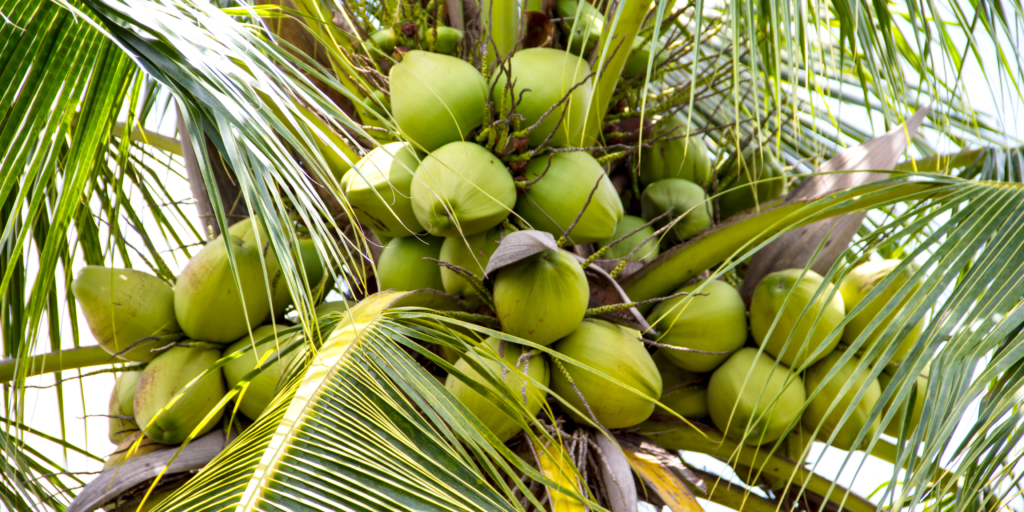Introduction
Vietnam is known for its rich agricultural landscape, with coconut farming being one of its most notable sectors. With a perfect blend of favorable weather conditions, rich soil, and a long-standing tradition of coconut cultivation, Vietnam has positioned itself as a leading player in the global coconut market. This article explores the export potential of Vietnamese coconuts, highlighting the industry’s growth, challenges, and opportunities in the international marketplace.

1. The Coconut Industry in Vietnam
Vietnam’s coconut industry is largely centered in the Mekong Delta, an area that is home to about 90% of the country’s coconut production. The region’s tropical climate, combined with abundant rainfall and high humidity, creates ideal conditions for coconut farming. The coconut tree thrives in this environment, making it a sustainable and important crop for local farmers.
In recent years, coconut cultivation in Vietnam has been growing steadily, with farmers increasingly adopting modern agricultural techniques and practices. As a result, Vietnam has become one of the world’s top exporters of coconuts, meeting the demands of both international and domestic markets.
2. Key Coconut Products for Export
Vietnam produces a wide range of coconut products, with both fresh and processed varieties available for export. The most common coconut products include:
- Fresh Coconuts: The fruit itself, often sold with the husk or with the outer shell removed, is highly sought after for its refreshing water and nutritious meat.
- Coconut Water: One of the most popular products on the market, coconut water is consumed worldwide for its health benefits, including hydration and natural electrolytes.
- Coconut Oil: Used in food, cosmetics, and pharmaceutical products, coconut oil is a significant export product from Vietnam, prized for its health benefits and versatility.
- Desiccated Coconut: This is finely grated dried coconut meat, widely used in baking, cooking, and in the production of coconut-based products.
- Coconut Shells: These are used for charcoal production, handicrafts, and even in the beauty and personal care industry.
Vietnam’s ability to produce these diverse coconut-based products increases its appeal as a global supplier, providing a wide range of options for international buyers.

3. Export Growth and Trends
Vietnam’s coconut exports have seen impressive growth in recent years, driven by the increasing global demand for coconut products, especially in developed markets like the United States, Europe, and Asia. According to the Vietnam Coconut Association, Vietnam’s coconut exports have grown by more than 10% annually over the past decade, with demand particularly strong in the beverage and health food industries.
This growth can be attributed to several factors:
- Increased International Demand for Health Products: As consumers become more health-conscious, the demand for natural products like coconut water and coconut oil has skyrocketed. The growing trend towards plant-based diets also fuels this demand.
- Better Export Infrastructure: Vietnam’s government and private sector have made significant investments in improving logistics and export infrastructure, ensuring that coconut products reach international markets efficiently.
- Rising Global Awareness: With the increasing awareness of the environmental and health benefits of coconut-based products, more and more consumers are seeking out Vietnamese coconuts and derivatives.
4. Challenges in the Coconut Export Industry
Despite its growing success, the coconut export industry in Vietnam faces several challenges:
- Climate Change: The Mekong Delta is vulnerable to rising sea levels and changes in rainfall patterns, which can affect coconut production. Farmers are increasingly facing unpredictable weather, which can reduce yields.
- Quality Control: As the demand for Vietnamese coconuts grows, maintaining consistent quality standards becomes crucial. The government and industry stakeholders must work together to ensure that coconut products meet international standards, especially when it comes to hygiene and safety.
- Competition from Other Coconut-Producing Countries: While Vietnam is a top producer, it faces competition from other countries like the Philippines, Thailand, and Indonesia, which are also strong players in the global coconut market. Vietnam must continuously innovate and improve to maintain its competitive edge.
5. Opportunities for Growth in the Export Market
Vietnam’s coconut export industry is poised for further growth, with several opportunities to expand and strengthen its position on the global stage:
- New Markets in Emerging Economies: While traditional markets like the United States and Europe remain strong, there is significant growth potential in emerging markets such as China, India, and the Middle East. These regions are witnessing a rising demand for coconut-based products, and Vietnam is well-positioned to meet that demand.
- Product Diversification: Beyond the traditional coconut products, there is a growing market for value-added coconut products such as coconut-based snacks, beauty products, and eco-friendly packaging materials. Diversifying product offerings will help Vietnam capture new consumer segments and enhance its export potential.
- Sustainability and Eco-Friendly Products: As global consumers become more environmentally conscious, there is increasing demand for sustainable and eco-friendly products. Vietnam can capitalize on this trend by promoting coconut-based products as natural, renewable, and sustainable alternatives to plastic and other materials.
- Improved Certification and Branding: Vietnamese coconut producers can gain a competitive advantage by obtaining international certifications such as organic and fair-trade certifications. Additionally, strong branding and marketing efforts can help position Vietnam as a premium supplier of high-quality coconut products.
6. Conclusion
The export potential of Vietnamese coconuts is immense, driven by the country’s ideal growing conditions, diverse product offerings, and the growing global demand for coconut-based products. While challenges such as climate change and competition from other coconut producers remain, the opportunities for growth are significant. By continuing to innovate, improve quality control, and tap into new markets, Vietnam can strengthen its position as a leading global supplier of coconuts and coconut products.
As global consumers become increasingly health-conscious and environmentally aware, Vietnamese coconuts are well-positioned to meet this demand and continue their upward trajectory in the international market.

